Elevating vitamin C content via overexpression of myo-inositol oxygenase and l-gulono-1,4-lactone oxidase in Arabidopsis leads to enhanced biomass and tolerance to abiotic stresses
- PMID: 25767369
- PMCID: PMC4354779
- DOI: 10.1007/s11627-013-9568-y
Elevating vitamin C content via overexpression of myo-inositol oxygenase and l-gulono-1,4-lactone oxidase in Arabidopsis leads to enhanced biomass and tolerance to abiotic stresses
Abstract
l-Ascorbic acid (vitamin C) is an abundant metabolite in plant cells and tissues. Ascorbate functions as an antioxidant, as an enzyme cofactor, and plays essential roles in multiple physiological processes including photosynthesis, photoprotection, control of cell cycle and cell elongation, and modulation of flowering time, gene regulation, and senescence. The importance of this key molecule in regulating whole plant morphology, cell structure, and plant development has been clearly established via characterization of low vitamin C mutants of Arabidopsis, potato, tobacco, tomato, and rice. However, the consequences of elevating ascorbate content in plant growth and development are poorly understood. Here we demonstrate that Arabidopsis lines over-expressing a myo-inositol oxygenase or an l-gulono-1,4-lactone oxidase, containing elevated ascorbate, display enhanced growth and biomass accumulation of both aerial and root tissues. To our knowledge this is the first study demonstrating such a marked positive effect in plant growth in lines engineered to contain elevated vitamin C content. In addition, we present evidence showing that these lines are tolerant to a wide range of abiotic stresses including salt, cold, and heat. Total ascorbate content of the transgenic lines remained higher than those of controls under the abiotic stresses tested. Interestingly, exposure to pyrene, a polycyclic aromatic hydrocarbon and known inducer of oxidative stress in plants, leads to stunted growth of the aerial tissue, reduction in the number of root hairs, and inhibition of leaf expansion in wild type plants, while these symptoms are less severe in the over-expressers. Our results indicate the potential of this metabolic engineering strategy to develop crops with enhanced biomass, abiotic stress tolerance, and phytoremediation capabilities.
Keywords: Vitamin C; ascorbic acid; phytoremediation; plant growth; stress tolerance.
Figures


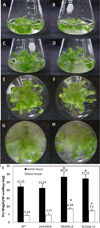
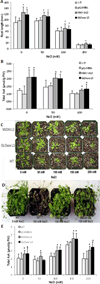
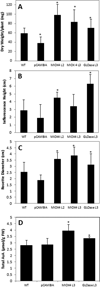
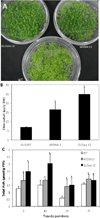
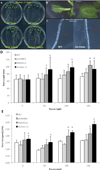
Similar articles
-
Characterization of the response to abiotic stresses of high ascorbate Arabidopsis lines using phenomic approaches.Plant Physiol Biochem. 2020 Jun;151:500-515. doi: 10.1016/j.plaphy.2020.03.038. Epub 2020 Apr 9. Plant Physiol Biochem. 2020. PMID: 32302943
-
Mechanisms underlying the enhanced biomass and abiotic stress tolerance phenotype of an Arabidopsis MIOX over-expresser.Plant Direct. 2019 Sep 2;3(9):e00165. doi: 10.1002/pld3.165. eCollection 2019 Sep. Plant Direct. 2019. PMID: 31497751 Free PMC article.
-
L-Gulono-1,4-lactone oxidase expression rescues vitamin C-deficient Arabidopsis (vtc) mutants.Plant Mol Biol. 2003 Dec;53(6):837-44. doi: 10.1023/B:PLAN.0000023671.99451.1d. Plant Mol Biol. 2003. PMID: 15082929
-
Manipulation of Ascorbate Biosynthetic, Recycling, and Regulatory Pathways for Improved Abiotic Stress Tolerance in Plants.Int J Mol Sci. 2020 Mar 5;21(5):1790. doi: 10.3390/ijms21051790. Int J Mol Sci. 2020. PMID: 32150968 Free PMC article. Review.
-
Increasing ascorbate levels in crops to enhance human nutrition and plant abiotic stress tolerance.Curr Opin Biotechnol. 2017 Apr;44:153-160. doi: 10.1016/j.copbio.2017.01.011. Epub 2017 Feb 21. Curr Opin Biotechnol. 2017. PMID: 28231513 Review.
Cited by
-
Potential of engineering the myo-inositol oxidation pathway to increase stress resilience in plants.Mol Biol Rep. 2022 Aug;49(8):8025-8035. doi: 10.1007/s11033-022-07333-0. Epub 2022 Mar 16. Mol Biol Rep. 2022. PMID: 35294703 Review.
-
Vitamin C in Plants: From Functions to Biofortification.Antioxidants (Basel). 2019 Oct 29;8(11):519. doi: 10.3390/antiox8110519. Antioxidants (Basel). 2019. PMID: 31671820 Free PMC article. Review.
-
MsAREB1 enhances combined cold and saline-alkali stress tolerance by promoting ascorbic acid biosynthesis in alfalfa.Plant Biotechnol J. 2025 Aug;23(8):3349-3362. doi: 10.1111/pbi.70156. Epub 2025 May 26. Plant Biotechnol J. 2025. PMID: 40415591 Free PMC article.
-
Exogenous Myo-Inositol Alleviates Salt Stress by Enhancing Antioxidants and Membrane Stability via the Upregulation of Stress Responsive Genes in Chenopodium quinoa L.Plants (Basel). 2021 Nov 9;10(11):2416. doi: 10.3390/plants10112416. Plants (Basel). 2021. PMID: 34834781 Free PMC article.
-
Metabolic engineering in food crops to enhance ascorbic acid production: crop biofortification perspectives for human health.Physiol Mol Biol Plants. 2022 Apr;28(4):871-884. doi: 10.1007/s12298-022-01172-w. Epub 2022 Apr 19. Physiol Mol Biol Plants. 2022. PMID: 35464783 Free PMC article. Review.
References
-
- Alhagdow M, Mounet F, Gilbert L, Nunes-Nesi A, Garcia V, Just D, Petit J, Beauvoit B, Fernie AR, Rothan C, Baldet P. Silencing of the mitochondrial ascorbate synthesizing enzyme l-galactono-1,4-lactone dehydrogenase affects plant and fruit development in tomato. Plant Physiol. 2007;145:1408–1422. - PMC - PubMed
-
- Alkio M, Tabuchi TM, Wang X, Colon-Carmona A. Stress responses to polycyclic aromatic hydrocarbons in Arabidopsis include growth inhibition and hypersensitive response-like symptoms. J Exp Bot. 2005;56:2983–2994. - PubMed
-
- Athar HR, Khan A, Ashraf M. Exogenously applied ascorbic acid alleviates salt-induced oxidative stress in wheat. Environ Exp Bot. 2008;63:224–231.
-
- Barth C, De Tullio M, Conklin PL. The role of ascorbic acid in the control of flowering time and the onset of senescence. J Exp Bot. 2006;57:1657–1665. - PubMed
Grants and funding
LinkOut - more resources
Full Text Sources
Other Literature Sources
Molecular Biology Databases
